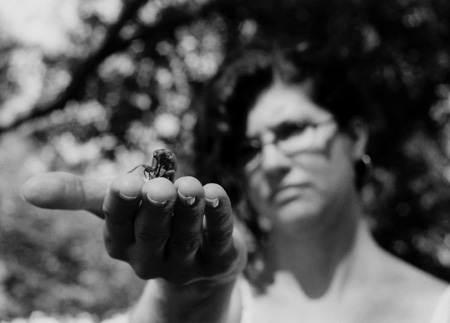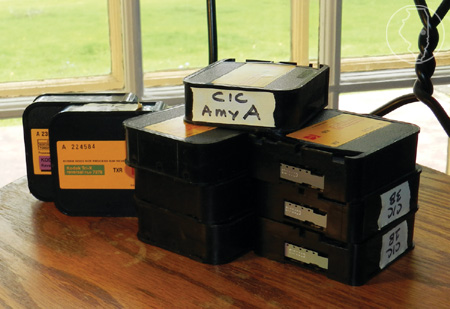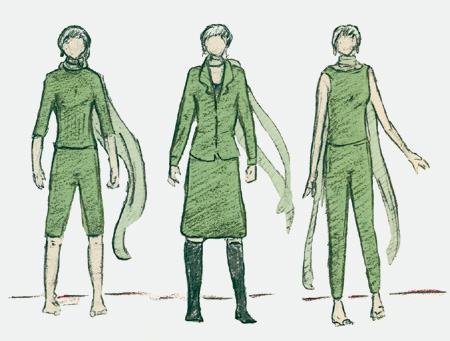Cicadas fashioned to fit allegory

~~~~~
My review posted here at C-U Blogfidential last week about the Kim Adelman short-filmmaking book got me to thinking about things, just like we are wont to do. Three of them happen to be the three films-of-sorts I attempted to produce during the MICRO-FILM era. One is the one that leaves me longing in its unfinished state, another had its moment to flicker in the local underground, and the last I have yet to bring up on this forum until now. Not unlike what inspired a similar article from last spring, I uncovered a piece of artwork from the mystery movie while sorting through old files in support of other content. The visual artifact is of a time when I fancied myself a late bloomer, witnessing the deluge of output from young people as I did on a regular basis thanks to MF and the Freaky Film Festival, which I thought unique enough to share for my kicks and your inspection. Here we go, 15 years after the fact…
Long-time friends and comrades in culture know I am the antithesis of a snappy dresser, but I forced myself to put on a style hat and conceptualize what a pair of figure abstracts might look like for a Super 8 lark I began filming in the late summer of 2004. The footage I did manage to capture – we’ll get to a chemically-imbalanced caveat in a few moments – featured the awesome Amy Rund wandering about her ennui as depicted by southwest Champaign foliage and the sunken garden at the University of Illinois’ Allerton Park near Monticello. What catches her attention is the shell of a cicada nymph left clinging to tree bark. Since this is typically the most that us humans witness when the insect molts from adolescent to adult, her character is supposed to enter a trance showing it in an anthropomorphized way.
How should we accomplish such a sequence, then, without being cheekily literal or gruesomely visceral? I did not have anyone specific in mind when I drew my initial ideas. Amy and I believed that casting younger for someone with experience in performance might be the best route, with the implication being her character is flashing back to a transformative moment in her past. I wondered if two actors might bring more range to the before/after dichotomy on screen and allow for both to be present in that precise moment when one supersedes the other. I also wished to avoid the potential headache of handling makeup effects in an outdoor setting, so I ultimately counted on attainable fashion sense and deliberate choreography to bring this to life in the spirit of the popular “dance on camera” genre.
~~~~~
~~~~~
You may now click on the thumbnail above to view the entire art board. Pairing drab and cold dress next to blue-green couture is an obvious conceit to signify the stages, while my imaginary models are distinct in their postures and facial forms to reflect my casting intentions. One performer certainly could have worked for both if they were adventurous enough; I imagined any possible talent to be connected to faculty or upperclassmen who might take on the opportunity to shape how they moved through frame. I probably would have scattered flashes of them through the early Amy scenes and then let it all unfold before a denouement picturing our lead walking towards a welcoming expanse as in her future. Maybe it wasn’t the most sophisticated approach to addressing a middle-age yearning – the entire concept rested on a whim instead of a script – but it might have made for something a bit sensually different.
We did not get much further with the project. Other than the partly improvised Super 8 scenes and 35mm still photographs of Amy in the locations, I captured some interesting shots across a two-day period of a nymph shedding its skin and emerging as an adult. Thank goodness my camera had a macro lens! Then again, to this day I still don’t know if it worked despite how it looked through the eyepiece. I never had the footage developed and that, as I’ve now seen firsthand, was a big mistake. Based on a recent experience with the patient Anke Voss of the Champaign County Historical Archives, I learned that black-and-white Tri-X reversal film cartridges I exposed a year before the cicada rolls had retained a definite image while Kodachrome 40 cartridges exposed at that same time produced a near blank. One can make out the ghostly impression of downtown Champaign in the latter if one squints hard enough.
The chemistry of Kodak’s color home movie stock is clearly unstable with age and I should not have hesitated in getting my rolls processed. Stored safely but not refrigerated at the Secret MICRO-FILM Headquarters, five of the nine cartridges are probably ruined. I don’t know that it’s worth the bother to find out if Amy and the cicada survived the Kodachrome threshold, considering how much costlier it is in 2020 to develop and transfer films than in 2004. Conversely, I might send off the remaining Tri-X and Plus-X reels to see what exactly the negatives have preserved for us like invertebrates in ash-hued amber. I know that I squandered the original potential for CICADA SONG, a title that I’ve attached to it in the ensuing years since we frolicked in the fields to film, although it still has a story to impress upon us.
~ Jason Pankoke
~~~~~

